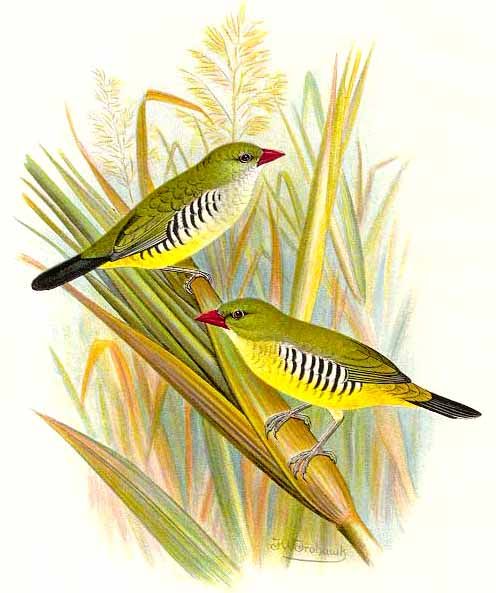|
| 질의: estrildid finch | 결과: 111번째/115 | |
Green Avadavat (Amandava formosa) - Wiki
| 제목: | Green Avadavat (Amandava formosa) - Wiki
| |

| 해상도: 496x593
파일크기: 44339 Bytes
등록시간: 2008:01:16 16:38:29
|
Green Avadavat
From Wikipedia, the free encyclopedia
Order: Passeriformes
Family: Estrildidae
Synonyms: Estrilda amandava
[Photo] Green Avadavat - Amandava formosa - Bengali vert. Author: Frederick William Frohawk (1861-1946). Source: www.oiseaux.net/photos/william.frohawk/green.avadavat.1.html
The Green Avadavat Amandava formosa is a species of estrildid finch found in central India, around southern Rajasthan, central Uttar Pradesh, southern Bihar and West Bengal, south to southern Maharashtra/northern Kerala and northern Andhra Pradesh.
Identification
The Green Avadavat is approximately 10cm long with a distinctive green-and-yellow avadavat, dark flank bars and reddish bill. Females are duller with indistinctly barred flanks. Both sexs have pale tips to wing-coverts and tertials. It is also identified that individuals may be dyed green by trappers. Its voice song is high-pitched warble, ending with prolonged trill with weak seee and swee notes.
Threats
The Green Avadavat has been traded as cage-birds in domestic markets since the late 19th century. An average annual of 2,000-3,000 Green Avadavat are smuggled out of India to Europe and America. This species is vulnerable to stress, and a high mortality has been noted in trapped birds. Most of its natural grassland habitats are being destroyed by farmers for agriculture purposes and further degraded by increased in usage of pesticides and insecticides. Therefore, this species has faced a rapidly declining population.
Conservation measures
Green Avadavat is legally protected in India, and trades have been banned since 1981. It is currently been conserved in four protected areas, the Desert National Park and Taal Chappar Wildlife Sanctuary, both in Rajasthan, Kahna National Park in Madhya Pradesh and Melghat Sanctuary in Maharashtra. There are some conservation measures been proposed such as to identify locations of the remaining populations, followed by investigation of its ecological requirements and tolerance of habitat degradation to establish its current distribution and population status. And upgrading the species's legal protective status to Schedule I of the Wildlife Protection Act (1972) and CITES Appendix I.
http://en.wikipedia.org/wiki/Green_Avadavat
| The text in this page is based on the copyrighted Wikipedia article shown in above URL. It is used under the GNU Free Documentation License. You may redistribute it, verbatim or modified, providing that you comply with the terms of the GFDL. |
|
^o^
동물그림창고 똑똑전화 누리집
^o^
|
|